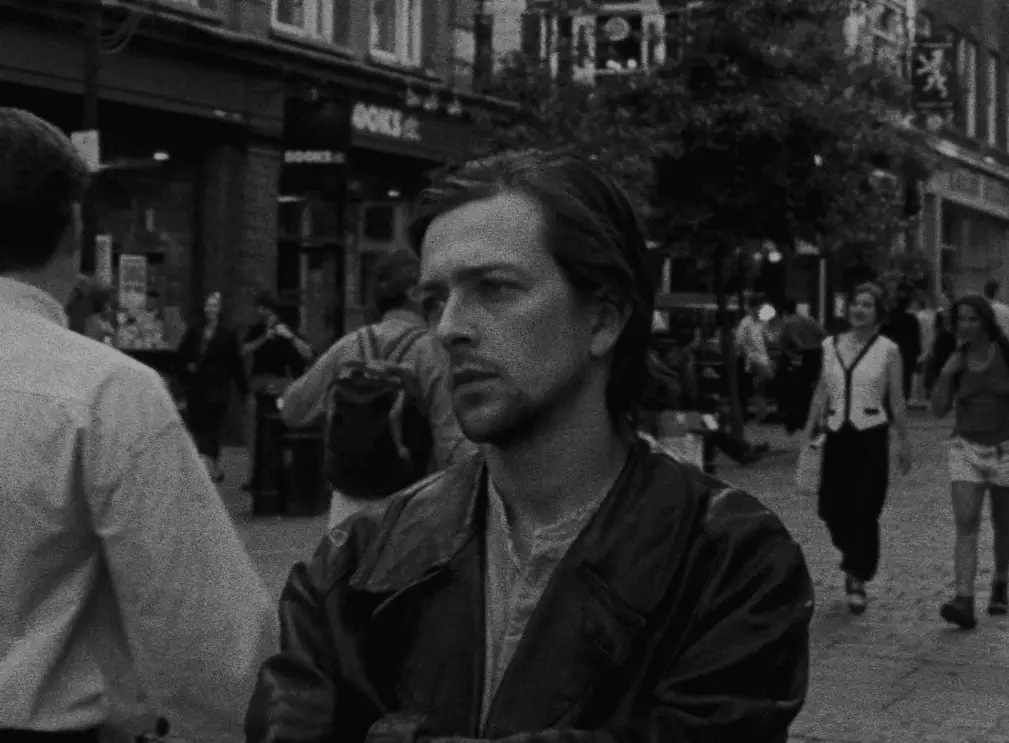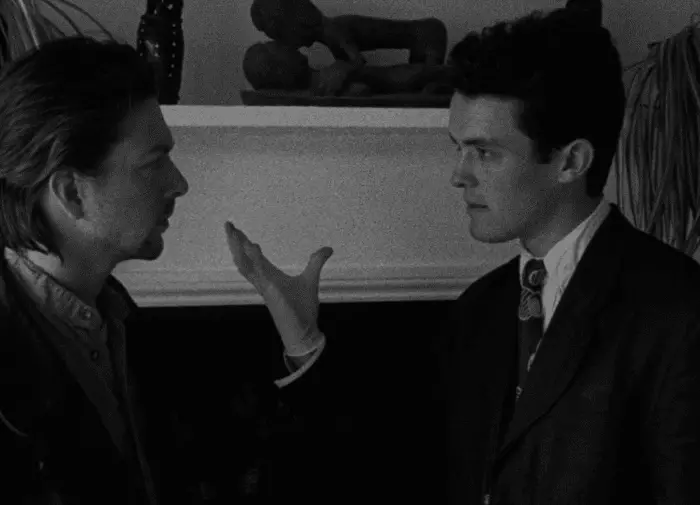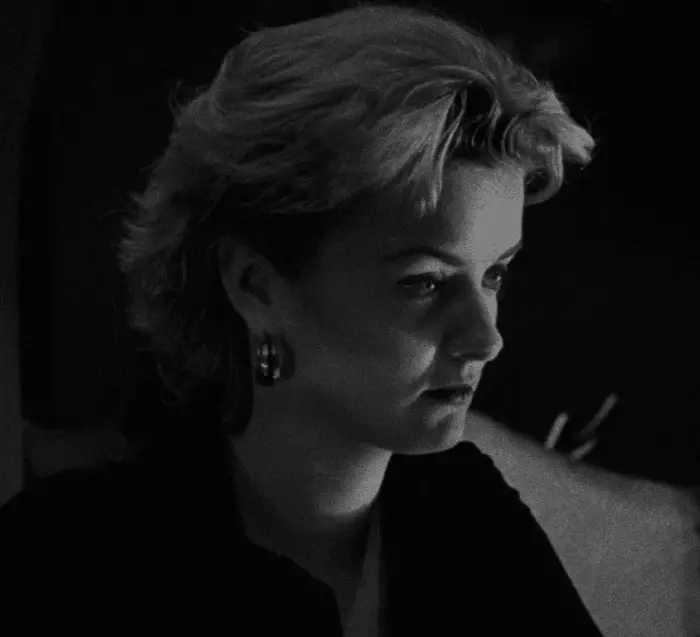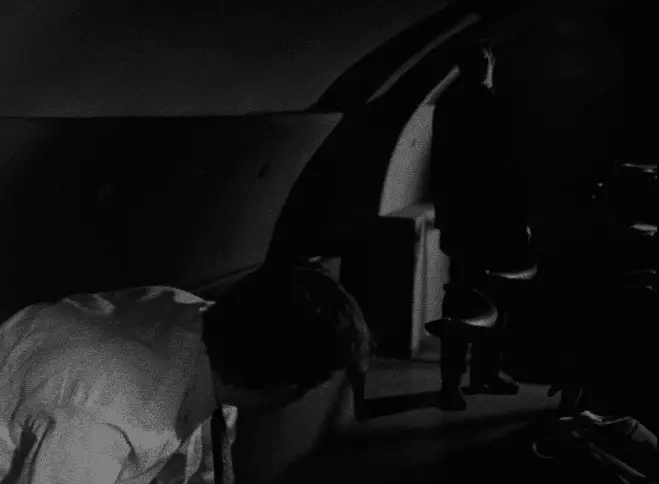There was a moment in Christopher Nolan’s career—maybe it began with The Prestige, or maybe something more like Inception, and no doubt influenced by the success of his Batman films—where the director seemingly graduated from making mid-budget, psychologically puzzling crime thrillers to directing some of the most ambitious and mind-bending blockbuster films that come out of modern Hollywood. But before any of that happened, Nolan set out to prove himself with Following, which dabbles in so many of the elements that make up his style even today. Twenty-five years later, it still makes for a fascinating look into what gives Christopher Nolan films their identity.

Following centers on a young man named Bill, credited as just “The Young Man” (Jeremy Theobald). The Young Man is a lonely writer in London who begins making a hobby of following people around the city, just to observe them and their lives. One day, he gets caught in the act by a shrewd followee named Cobb (Alex Haw), who also makes a habit of spying on people. But Cobb is more aggressive—he breaks into apartments, steals things. He ropes the main character into his schemes, and before long the Young Man gets in just a little too deep.
Cobb presents an interesting challenge to The Young Man. Where The Young Man sees his hobby as risky and intrusive, an adventurous thing to get into while he’s bored, Cobb’s break-ins show that he doesn’t go nearly far enough in really getting to know people. In this way Following kind of misdirects with its premise—it might really be called Burgling, based on how much proportionate share of the film’s story and thematic heft come from the actual burglaries rather than the Young Man’s followings.
Perhaps before any of that, the most immediately noticeable elements of Following are its visual style. The exceptionally grainy black-and-white gives it a distinctly old look that feels authentic. One could feasibly argue that it takes place in any decade of the twentieth century. It’s a strong visual homage to old film noir, and the film also often employs moody contrasts and lighting to great effect for what is clearly limited resources. The cinematography does a lot of heavy lifting here; it is the visual work and its novelty that help it feel like more than just another psychological thriller.
Nolan’s introduction has interesting things to say beyond its visuals, too, even if they are somewhat half-baked. The character of Cobb seems to have a kind of philosophy to his break-ins, maybe a twisted sense of purpose. In their first joint break-in, Cobb shows the Young Man a box of private possessions belonging to whoever lives in the apartment they’re in. He explains that people, deep down, actually want to be seen for their most private possessions and expressions of self, even if they don’t think they do. Their sense of security and comfort is something that they take for granted.

“That’s what I do. Concealment, display, both sides of the same coin…You take it away, and show them what they had,” he says. Cobb seems like a character that enjoys, above all else, making people feel violated. Throughout the film, he seems to care little about money or stealing valuables. He steals underwear and takes it with him, and gives the Young Man a stolen credit card without a second thought. Of course, Cobb is very specifically trying to frame the Young Man, so his choices might be seen in that light. But Cobb does seem genuinely intent on making people feel as if their life has been invaded, and that someone out there who they don’t know actually knows them well.
There is also the character of “The Blonde” (Lucy Russell), an archetypical femme fatale keeping secrets from the young man. She is, of course, much more complicated than she appears to be, and she is eventually shown to be an associate of Cobb’s, scheming with him to frame the Young Man. Her presence in the film is straight out of classic Hitchcock or film noir—she is seductive, duplicitous, scheming. She ticks a box for a noir story, but Russell also injects the necessary flare and complexity into her performance.
The Blonde, furthermore, is also notable for the way she pokes fun at the Young Man and the archetype of the lonely writer. Perhaps the funniest delivery in the film is when The Blonde is in the Young Man’s apartment, sitting on the couch, and the Young Man explains that he’s a writer before taking a cheeky tap on his typewriter.
She lets out a solitary, unimpressed “ah.”
There is also a scene much later in the film where the Blonde’s mocking of the Young Man really drives home one of Following‘s key themes. The Young Man confronts her in her apartment after a robbery gone wrong in which the Young Man ended up killing someone. She reveals the ultimate scheme that she and Cobb were pulling on him, setting him up to appear like a burglar with a similar MO to Cobb to get the police off Cobb’s back.
“You were just a sad little f*cker waiting to be used,” she says. “It’s not that serious.”

This comes across at times like Following is written with a sense of insecurity about the archetype of the aimless, undisciplined writer. The Young Man is looking for inspiration—he wants to write, but he doesn’t necessarily have much interesting to say. He tries to find this abstract sense of artistic purpose through the lives of others. Cobb, as a foil to this, finds pleasure in invading the lives of others but is not trying to turn that into something more than it is. He’s less purposeful with his work, but also smarter, more disciplined, and more in control.
Following’s non-linear structure tries to recontextualize the events of the film as well. The film regularly cuts back and forth between an earlier and later period, clearly marked by the Young Man’s appearance, either disheveled and greasy or clean-cut. When the Young Man goes to the Blonde’s apartment, she tells him that she was just robbed, and is feeling afraid and violated. The viewer only needs to guess whether or not Cobb and the Young Man did it until minutes later, when the film shows them breaking in to the same apartment. Cobb steals her underwear, they steal a single earring and hide it, among other things.
The slightly out-of-order storytelling is intriguing in its attempt to create a more mysterious unfolding of events and information, but it does not necessarily have a profound effect on the viewing experience. The experience of watching the linear edit present in the Criterion release is relatively similar, especially later in the film’s short runtime. But ,as with all strange and challenging artistic choices, it does not necessarily need a purpose; it is there, and it is a fun and relatively novel element of the film. It’s this kind of playfulness with time and chronology that Nolan used to masterful effect in Memento and in Following displays a curiosity and creativity that only had to be honed by experience.
Upon release, Following was rightly identified as a sign of a burgeoning talent wearing his inspirations on his sleeve to artful effect. David Thompson of Sight and Sound praised Nolan’s visual work in creating a cinematic London “of mysterious, disquieting corners with more than a tang of Godard’s vision of Paris in Alphaville (1965).” The New Yorker similarly acknowledged Nolan’s clear allusion to Hitchcock and classic film noir. Others praised its lean runtime, with the Los Angeles Times’ Kevin Thomas relishing “the sheer nastiness [Nolan] keeps stirred up, unabated for 70 minutes,” although this might overrate the film’s actual “nastiness.” TV Guide, meanwhile, calls Following “Short, sharp and tough as nails.” Indeed, the quick runtime is something Nolan might be said to have abandoned wholeheartedly in recent years, although the effect of that on his work is, certainly, more of a matter of taste.

Following thus has many seeds of what would later become staples of Christopher Nolan’s style as he took on larger budgets and expectations. His penchant for complex, mind-bending storytelling, his nostalgic visual lens, it’s all there, apparent even before his first real breakthrough with Memento.
It works, furthermore, in the opposite sense, too—there are elements of Following that Nolan has not necessarily touched much since. Perversion, voyeurism, loneliness are things one might not immediately associate with Nolan’s filmography, which makes Following even more fascinating just as a time capsule. As he continues to pump out ambitious blockbuster films, he certainly hasn’t abandoned his sense for complexity. One can’t help but wonder, though, what he might do if he ever returned to the small scale on which he cut his teeth with the resources he inevitably commands as one of the most famous filmmakers in the world. Following ultimately shows that while the director may have lacked in resources at one time, he never lacked ambition and vision.
To Nolan’s credit, his next film Oppenheimer, set to release next month, appears to be something of a departure from his usual high-strung science fiction and intense action. Oppenheimer is, of course, expected to be a relatively straightforward historical drama, as opposed to Nolan’s usual route of high-strung science fiction and intense, elaborate action. without having seen the film, it does still appear to keep his penchant for scale and spectacle in another genre, and, of course, it remains to be seen if he might still engage in twisty antics with time or similar concepts like what he did with the otherwise straightforward Dunkirk. But Oppenheimer, at least by convention, charges the director with doing sincere and complex character work, something that films like Tenet or Dunkirk have not really pursued. It remains to be seen how Nolan will engage with the flawed, complicated characters involved in the Manhattan project twenty-five years into his career.



